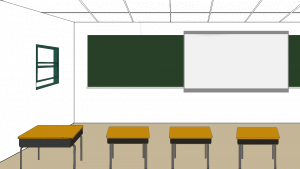My Experiences in a Classroom:
For most of my classes, the learning environment was relatively clean and ordered. The classroom consisted of desks in a row, separating students from collaboration. Teachers would stand at the front of the room, while students would listen, not interrupting. There was no noise, just the teacher’s voice. When there were assignments, students would stare down at their desks and try to finish their assignments while not talking with each other. The classrooms felt confining since there was not much connection to others.
Teachers always had big desks and rules on the whiteboard. As well, the teacher’s belongings took up a lot of space, restricting space in the classroom. Having many belongings disrupted the order of the room showing instant dominance. In contrast, students had small desks with chairs welded to them, making students face forward. It was like this until grade 7 or 8. This did not change until high school when the chairs were not welded to desks. Additionally, teachers had large computers, which were another dominant symbol over students’ small laptops. The classroom deemed the teacher as the most powerful in the room. This is evident because every classroom had a teacher’s massive desk at the front or back of the room. Teachers also always spoke their rules at the start of the class, which made the classroom feel as if students had no power. There was also a whiteboard, which would contain all the information as the teachers spoke. Then students would simply rewrite what the teacher wrote for memorization. That is significant in the power relationship since it instantly shows whatever is written by the teachers is valuable by authority. Also writing takes time, so when the teacher writes, it shows that wasting time when writing is important, but when students waste time, it is seen as less valuable even if it helps their knowledge. This is noticeable when students share stories or knowledge, that individuals want to quickly dismiss since it seems like a waste. The student making these connections in their stories are learning, and the learning can spread to other students during this story. Learning during a discussion is far more valuable to students than writing it down.
Most classes divided students into either small groups or individually by desk organization. As well, assignments normally were done alone, and there were not many discussions. Every class had a small group of friends or it was an individual experience. I never got to know all my classmates. The reason I did not get to know them is the classroom being designed or us to face the front. The boards were at the front and so was the teacher. Students need to discuss topics with each other. Student communication is a valuable tool for students and teachers. Communication allows students to understand better by either explaining the topics or asking about them.
I always felt secure in classrooms, but I did not feel relaxed in most classes. I thought they were always making an environment for my learning, which felt safe, but comfort is needed as well. I feel students should not be on alert all the time in a classroom environment. To achieve comfort some teachers had bean bags and books for us. They let us talk to them at lunch and helped us with every little thing by making themselves available.
Teachers could make a classroom more relational and inviting by asking students how they are and being invested in their lives. I know students might not be around for more than a couple of years, but that relationship and care given to them helps them in life. It is important to be invested in their activities and lives. Teachers can also be a part of discussions, allowing the students to go on their own path. Teachers can make more engaging group projects besides presentations, which makes students form relationships. Another aspect of this would be making the project fun and giving the students enough time to truly do it, leaving the stress on the side for a bit. Since there is much more than student-to-student interactions, we could involve more discussions, allowing everyone an equal chance to speak, including teachers. There may also be a place for students to relax with chairs and including small trinkets around the room that initiates discussions. A small trinket or poster could do the trick by inspiring friendly communication. Furthermore, the ideas of family and culture could be spoken about, relating the topics of class to themselves and their lives, which has students make a relationship with the course material. Teachers could start referring to the classroom space as the classes’ not only the teachers room. We can negotiate rules together and speak with students as equals.
Here is an image of the basic classroom we all know:
